Recent Articles
-
Christmas Sword Buying Guide 2025
Dec 03, 25 10:53 PM
The Swords of Cheness Cutlery
Cheness Cutlery may be one the newest contenders in the market for fully functional yet affordable Katana, but have already created quite a stir.

A refreshingly honest merchant, Mr. Paul Chen (not to be confused with his greatest rival, Paul Chen of the Hanwei Forge!) is very upfront when it comes to describing his swords - no frills, nothing fancy - just an affordable and functional Katana at an excellent price...
So if you are wanting to know what all the fuss is about, this review sent to me by Mr. J.D. Daniels of Kansas gives you the low down on this interesting, emerging sword company - Cheness Cutlery.
PLEASE NOTE: The Laminated 'Higo' Katana has been discontinued and is no longer in production. However, I think you will find this article to still be of interest as many points are still very relevant to Cheness swords in general...
The Higo Katana by Cheness Cutlery
Review by J.D. Daniels, Kansas, USA
I first started my search to look for a REAL samurai sword about two or three years ago. I have to admit that I didnt know anything at all about it
And I still dont.
I was inundated with a plethora of Japanese terminology that did more to confuse me then it did to help and since I did not participate in any of the martial arts it was becoming very clear to me, I was out of my league and sinking deeper with each question I asked.
My search was limited to just pictures on E-Bay and dealing with the hierarchy of Sword Forum International. My standard search scenario usually consisted of finding a blade that looked good and ask a question on internet forums like SFI or Bugei. I wont admit I wasted my time doing so, in fact I have learn quite a bit but as I said earlier there is a definite hierarchy on the subject and it is there for a good reason.
As I searched, I learned that when selecting a Katana sword it is very similar to picking the right tool for the job. Even though it is possible to fix a car with a pair of pliers, you do a much better and cleaner job with a decent set of good tools.
|
"Therefore, you have to look at a sword |
Now, I dont know about you but I have a garage full of tools and each of my tools has a specific job. Katanas share the same philosophy. There are multitudes of different katanas that do several jobs that the arts require.
The job I had in mine for my Katana was simple. It would be prominently displayed in my office next to my gun collection. I am a weapons collector. So why didnt I just buy any old wall hanger?
Well I did
And it looked like crap. After looking at what a wall hanger consisted of it had become quite clear that this was definitely un-safe and bared the badge of poor quality.
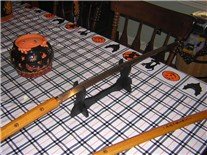
I dont know what I was thinking
maybe that was my problem
NOT THINKING!
I have spent most of my life researching firearms not swords so why did I skimp on the process this time. Well, it is a new field of weapons for me and I did the same thing when I started on firearms. I guess there are some lessons best
learned the hard way and some are worth repeating.
I wanted a sword that was razor sharp and when you held it, it felt like it could do some damage. I wanted a blade that could not be mistaken for being fake or be considered a prop. My wife commonly refers to this as a generation Xer, Mid-life crisis!
I eventually did find another blade but if it was not functional or to say the least, I wasnt going to wield it. The blade was made of a fairly descent 1045 steel which is better then most knives I have owned and it was sharp. Nevertheless, as I read more about Katanas, the blade I had bought, was not functional as a cutting Katana. It was nothing more then a top notch wall hanger.
This wasnt going to fulfill what I had desired.
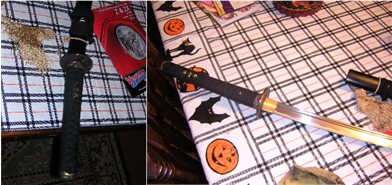
Meanwhile, back at E-Bay
Since I did not know who made the sword I had bought. I rifled thru the endless pictures hoping to find out who manufactured my blade when I came across Cheness Cutlery who so happened to have a similar blade as mine. So I E-Mailed him and asked.
He was quick to respond, friendly and very helpful.
Cheness Cutlery is owned and operated by Paul Chen of La Jolla California just outside of San Diego. HE IS NOT OF THE HANWEI FORGE.
Paul and his wife are both practicing the art of Kendo and Iaido. They started Cheness Cutlery in late 2003 and began selling entry level Iaito katanas out of there home on E-Bay. He told me that it is not the intention of Cheness Cutlery to sell WALL HANGERS but to provide a cheap and viable solution to students of Kendo and Iaido who are getting there first sword.
He told me that his blades are of entry level carbon steel of 1045 -1060 grade and he tries to limit his retail price under $200. His interest in the business stemmed from years practicing kendo and iaido. It is the goal of Cheness Cutlery to stabilize the market so that more students in the martial arts can afford to buy an introductory cutting blade without risk of being scammed.
He also told me that it is actually quite difficult to sort through the gem from the junk for the $200 range katanas even for him. He wants Cheness Cutlery to build a reputation as a safe supplier that students of these martial arts can safely purchase without having to sort through the mess themselves.
|
"Cool! I like saving money and I like quality! However, I still was not sold..." |
I was here to find out about my sword, not to buy another sword. I was not about to be sweet talked by an internet salesman.
So I pried even further and sent him a picture of my blade to see if he could match it to other swords he has. Amazingly enough he did. The sword I had was altered by changing the Tsuba. (That would be the guard for those who are new to this). It was a Hanwei Tsuba.
Paul informed me that he sold the same blade with a wire brushed Hamon (The wavy leading edge) for $100 when he first started. He now no longer stocks it. He would prefer that he has improved his product by dropping those types of swords from Cheness' inventory. Which is not a bad move on his part?
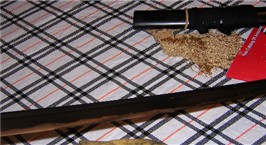
I established that the sword I had was not his but could have been made from the same forge he uses. This is ok by me. Nevertheless, he brought up another subject near and dear to my heart: HAMON!
"Nothing is more distinguishing on a Katana Sword like its hamon."
It is the leading edge and defining point of a blade that set itself apart from all others. It is after all, one of my main reasons for buying a Katana. Paul educated me on this subject.
He said that in todays industry there are many methods used to put a hamon on a blade. He pointed out that on my blade it was wire brushed. This can be viewed on his website,
here.
His best advice to me was not to buy a sword based on a Hamon alone. So I asked him what he would recommend for someone like me. A Higo iaito blade. What is it? Well it is the sword most practitioners of Iaido use and what some Dojos sensei recommend for there beginning students.
He had me hooked (Damn internet salesmen) So I bought it and here it is!
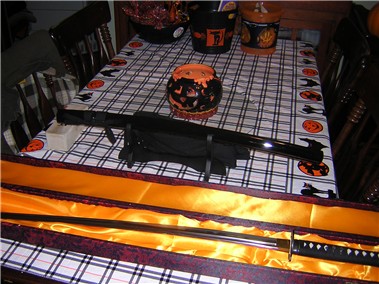
I ordered this blade on Wednesday October 27th and received it on Monday October 31st. Very fast turn around. It was in its presentation box.
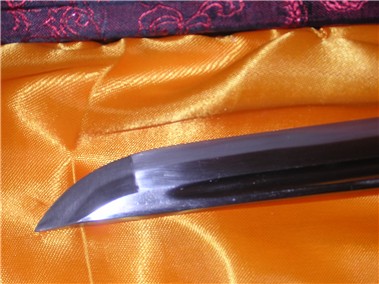
Now Paul mentions that the Kissaki was a sore spot for Cheness Cutlery.
The issue has more to do with the geometry of the curvature. This is common on blades like the lower-end Paul Chen Hanwei swords. A quality control issue that is being addressed.
Cheness Cutlery was going to try to improve upon this the next production line of blades. As far as I am concerned this does not effect me since I am using it as a wall hanger but it could be noticeable if I take up the art.
The swoop back of the hamon is a sign of a good blade but the non-swoop back (yakizume) is still a legitimate finishing method with the hamon. The Hamon itself, on the Higo blade, has a chemically etched Hamon with a fabric buff over.
Cheness Cutlery has other sword for sale on his website. They offers Mono-steel blades as well other types of wrap core blades like the Higo. This blade has a definite Hamon. The Higo wrap laminations process is best described as similar to the sanmai lamination, but it does not incorporate the use of shigane (Soft Metal). So it ends up being a cross of the sanmai and the wariha tetsu with the hardened steel extending deeper into the core of the blade.
This blade does not follow the traditional methods so I can not call it by any of the names. But if you want to understand more on the lamination process go to Brian Steins website for a better idea on lamination.
This Cheness Higo sword is a completely modern weapon or tool if you would prefer it to be called as such. It incorporates Modern steel, Modern design and Modern dimensions. It is meant for iaido practices so it has adopted what is necessary to function properly.
Another sore spot with him as well as other was the Bo-Hi. This is also known as the blood groove. Most people I have talked to tend to go either way on the subject. Some say they love the swooshing sound it makes when it is in motion. Others seem to think this is a sign of poor quality since its real purpose is to shave off weight.
Both in my opinion can serve me well. After all, this blade is weighing in at 2 Lbs and 9 oz. This in my opinion this is a mans blade. In addition, it does whistle when it is swung!
|
"So, why would I buy from a man who criticizes his own product? Because he does!" |
And to me that means Cheness Cutlery is definitely out to provide a better product.
The Cheness Higo is not a flashy sword. It is a very simple. You will not find Golden Dragons or Mean looking Samurais on the fittings. This blade is very plain and yet functional. Cheness cutlery is able to provide a great sword at a low price because there are NO Gold plated embossed cherry blossoms involved in the fittings or Tsuba. He does how ever offer those but it will cost you more.
|
"I have learned that when buying a sword it is the blade you should be after and not the BLING BLING that surrounds it..." |
Dont get me wrong those fittings serve a purpose but if the fittings are flashy and not well built this will become a major problem. If that is what you are after then Cheness Cutlery can sell you a more reliable set of fittings after the new year when he opens his line of higher end fitting in 2006.
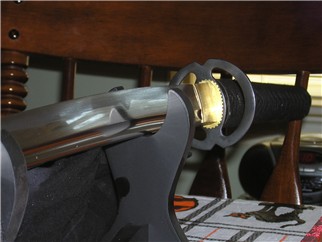
The Tsuka (the handle) on my Cheness sword seemed to be tight and well put together.
Although it isnt a high end Fred Loham Tsuka it is after all functional.
The Sageo is wraped and tied properly but it is held down by contact cement. The Same (Ray Skin) doesnt seem real but it isnt plastic nor is it soft.
So it may be real ray skin Im still out of my league on this.
The Tsuka, Tsuba and all the other fittings came together with the sword very nicely. It was held together with one wooden pin called the Mekugi.
I have found that in some Dojos the requirement that most instructors (sensei) ask for in a Iaito blade is to have two pins or Mekugi. The reason is simple. If one is to wear out then the other mekugi can act as a back up. Before you purchase a blade for Iaido be sure to have your sensei approval or recommendations.
Remember this sort of issue tends to fall under personal preference but dont fool yourself. It is a safety issue for many other people.
So the next time you look for a sword inspect the mekugi very closely! This particular blade followed the original tradition of having only one mekugi. The blade set well in the Tsuka and seemed not to feel loose after disassembly and reassembly.
|
"OK OK OK
Ive rambled on long enough
|
Well as I stated before, I am a collector! I am not skilled enough in the arts of Tameshigiri. But how do I know it cuts well?
In Kansas there is no bamboo or bamboo Tameshigiri mats. But what we do have a lot of is 12 to 18 foot tall Sunflower stalks. About 2 to 4 inches in diameter. And since I am a gardener by trade
ITS HARVEST TIME!
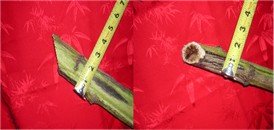
The picture (on the left) shows a fresh cut made by the HIGO on a live sunflower plant. Sunflowers have a soft center when dry but on a live plant, they are solid and very wet. (pictured on the right) They do not break easily or clean.
The cut was made in an upward thrush. The pic on the left shows a 2 diameter and the pic on the right is of a 1 width. Sun flower stalks are never perfect.
I also compared the cutting from my other ren fair sword. This would be the one with the Hanwei tsuba, and found that the cuts were not as clean as the Cheness Cutlery HIGO. I figured since it was made of1045 mono-steel and was razor sharp it should have done well. But it did not.
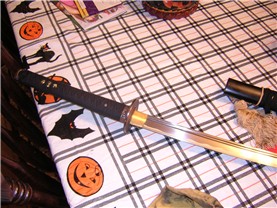
I let my wife take a whack at the sunflowers. I did this to see if it was just me or could some one with a smaller stature get the same results.
My wife had but one word to describe the blades performance: effortless. Then she wanted to know why I dont keep the kitchen knives that sharp. Well, I try to!
I know there many readers who are saying my machete could cut a sunflower down.
Well, my machete can too but it wears out quickly and it delivers a less then clean cut. The Cheness HIGO blade showed no signs of scratches or chips. It cleaned up well with the cleaning kit that was included.
The other Ren-faire sword didnt fair so well. The blade dulled quickly and had light scratches that had to be buffed out with a Scotch Bright pad. Well it is after all it is just a wall hanger.
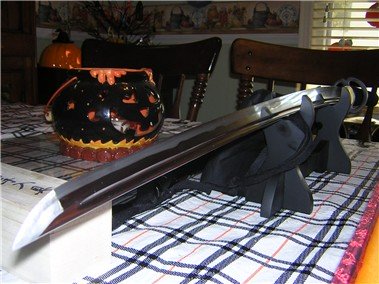
I would have to say that even though this is considered in some circles as a reproduction, I feel that I would have to remind you that it is a fully functional piece.
There are some issues with the handle and the fittings but yet, here again this could be altered into a much better sword if the user chooses to do so. These sorts of thing are what Cheness Cutlery had to do to keep the cost low and still provide a decent blade, which is what you should be looking for when you buy a sword. (A GOOD BLADE)
|
"I would recommend this sword to anyone interested in getting started collecting Katanas..." |
As far as it is being used in actual practice Iaido, I feel I am not qualified to give an opinion on such matters. As I stated before, I am a weapons collector, not a practitioner of the art. I am bringing you a perspective from a collectors point of view. At his current prices, it would be a nice to have a few of these to sell at the gun and knife show. But this blade is staying put.
Since I began this I feel I have learned a lot about the tool and now it is peaking my interest in the trade.
With all of Paul Chens experience and knowledge he was very helpful and courteous. I thought that he would tire of all of my silly quizzes, but he stayed in there and answered every one of my question. The Cheness Cutlery company website was also informative with a vast amount of information for beginners to view. You can look him up here.
Ill be doing business with this company again.
JD Daniels
WHERE TO BUY
Cheness Cutlery Swords are available at the very best prices online right here at the SBG Sword Store
I hope this information on Cheness Cutlery swords has been helpful. To return to A Beginners Guide to Buying Authentic Japanese Swords from The Swords of Cheness Cutlery, click here.

Buying Swords Online Can Be DANGEROUS!
Find the Best Swords in the:
Popular & Recommended ARTICLES

The ONLY true free online magazine for sword enthusiasts. Delivered once a month on the 1st day of the month, no filler and no BS, just the latest sword news & info delivered straight to your inbox.












